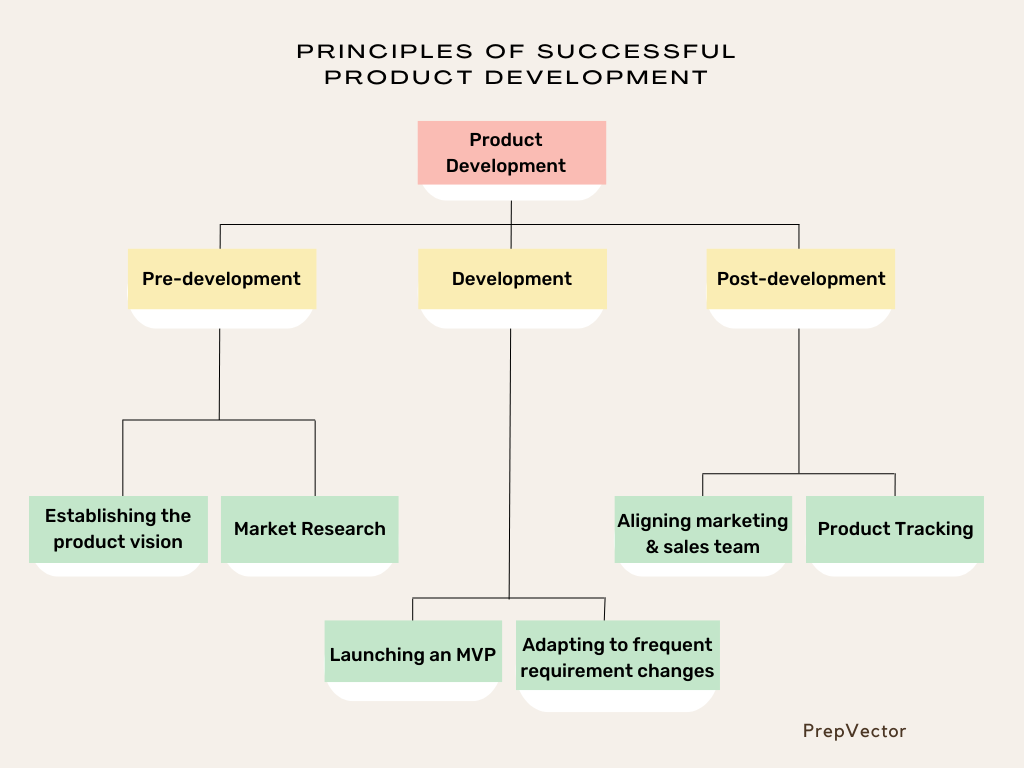Principles of Successful Product Development
Creating a product should be valuable and usable for the users, feasible to develop, and viable to business. When a product addresses these four ideas, then the product can survive and flourish into becoming a holistic product. The core responsibility of the product management team is to meet these criteria before delivering the product. It is important to make sure that the odds of your product achieving the goal are in favor. But how do we exactly estimate the product’s growth or success rate even before launching the product? We can anticipate the product to grow ambitiously when we implement certain principles that were constructed throughout the years. These product principles are fundamental truths established to enhance your product or service and in this blog, we have categorized different principles under different product development stages for better clarity.

Pre-product Development
1. Establishing the product vision
Product vision states the objectives of the product that is to be developed. It conveys the necessary information about the product, for instance, for who and why we are building this product. This is similar to the vision of a company that establishes the key objective that the company wishes to render for the public. For example, the vision of Amazon, the most renowned e-commerce website, is 'Build a place where people can come to find and discover anything they might want to buy online.
Establishing the vision statement can be a key source of motivation for everyone working in the company, or in our case, the product vision statement is a motivation for everyone involved in the product management team.
Create a product vision that is clear, short, attainable, and simple and make sure your product vision is unique from your competitor's vision statement. You can also make use of vision templates to draft your vision which will be easy to comprehend without any jargon. If your company develops a single product, which is widely known as a single-product company, then the company’s vision and product vision are the same. But if it's a multiple-product company, each product will have its product vision describing the objectives of the individual product.
Create a product vision that is clear, short, attainable, and simple and make sure your product vision is unique from your competitor's vision statement. You can also make use of vision templates to draft your vision which will be easy to comprehend without any jargon. If your company develops a single product, which is widely known as a single-product company, then the company’s vision and product vision are the same. But if it's a multiple-product company, each product will have its product vision describing the objectives of the individual product.
2. Market Research
Market research is the most crucial step in the development which most PMs overlook.
When the research is done properly, it will provide information about what the customers are anticipating. Without knowing your customers you can not develop a product that will solve their problems. Furthermore, the extensive research will provide information about the competitor’s plan of action and execution. With all this information, a proper plan to develop, deploy, strategize, and monetize can be outlined.
Product development
3. Launching an MVP
A minimum viable product is a great way to prevent huge capital investments from becoming ineffective. The idea behind releasing MVP is to understand how users are attracted to your product idea. After understanding the user interaction, the small-scaled product can be transformed into an ideal product with huge capital investments, or the idea can be scraped out and the process product ideation resumes. In such a way, the organization will not incur any financial losses. Many tactful product managers have implemented this idea into their development phase and with the recurring insights, they are currently a huge accomplishment. One of the prime examples would be Airbnb. They experimented with their idea with their apartment and realized the increasing attention received from the end-users. Later they expanded their idea and evolved as one of the top American rental companies. It is crucial to understand that the MVP that you are developing is going to introduce your product to the customers for the first time. First impressions leave a mark. Hence be vigilant with your work on the MVP.
They are similar to building prototypes that test your product with early customers.
4. Adapting to the frequent requirement changes
The prime reason why most companies and organizations switched to Agile methodology from Waterfall methodology is to introduce new changes and requirements at any phase of the development. Inputs and requirements change take place throughout the process. It is an inevitable aspect. If you neglect the arbitrary requirements raised, your product will not meet the standard that your users are expecting which will result in a product growth impediment. Hence to avoid this hindrance, always be open to new requirements and changes from the users or stakeholders. Be ready to anticipate changes and quickly adapt to them. One way to effectively track the changes and add new requirements is by using management software or tools.
Post-product Development
5. Driving the Marketing and Sales team at the right pace
This is the principle that deals with the financial aspect of the product. Begin with strategizing your product out to the people through advertising or reaching out to the advertising team of your company. When you reach the core audience or your target audience your product will end up in the right place with proper financial returns. As a product manager working with engineering, marketing, and sales teams is crucial. It is important to keep all three teams aligned to the vision we have set for the product. The engineering team is involved in the development phase. Post the development phase, the marketing team and the sales team steps in for the product to reach out to the customers.
As a product manager, you are responsible for how your product leads in the market. Hence, you should drive the marketing and sales team together because when these two passionate teams are in the same governance. Once your product crosses a milestone, for the product to sustain furthermore in the market you should compare the present statistics with the prior performance statistics. This is one of the certain ways to forecast your product’s future growth or decline and likewise, appropriate decisions can be made by the product manager.
As a product manager, you are responsible for how your product leads in the market. Hence, you should drive the marketing and sales team together because when these two passionate teams are in the same governance. Once your product crosses a milestone, for the product to sustain furthermore in the market you should compare the present statistics with the prior performance statistics. This is one of the certain ways to forecast your product’s future growth or decline and likewise, appropriate decisions can be made by the product manager.
6. Product Tracking
The responsibility of the product manager does not end once the product is deployed to the market. To keep the business growing, a PM should constantly track the product performance based on the market evolution and user preferences. If the performance is declining, a PM should take responsibility to identify the gap, design solutions to fix it, and optimize the product. Product growth can be determined by defining metrics, and designing systems to track those metrics continuosly. Many product managers always critically analyze that one metric(north star metric) that defines the growth of the product. Major tracking metrics include growth metric, product usage metrics, revenue metrics, etc. It is essential to pick the right metrics because it drives alignment within the team to optimize these metrics futher. In cases of conflicts like internal cannibalization of the product, these metrics are used to make decisions about product strategy.
The objective of these principles is to make sure your product aligns with the customer's expectations and keep everyone working on the project on the same page, thus increasing the production growth rate and also drive product revenue. Multiple teams collaborate to lauch good products and continually evolve them to meet the market needs. These principles help us unravel the hidden opportunities, find and fix bug, and track product health at different phases of product lifecycle. They are also helpful in identifying opportunities and building new features and products.
Check out our 8-week program - 'Master Product Data Science' to upscale your career!
Check out our 8-week program - 'Master Product Data Science' to upscale your career!

Copyright © 2022
Contact Us!
Got a question? Reach out to us and we will get back to you ASAP!
Thank you!
One more step!
Just a few details before you can download the resources.
Thank you!
Download your resource here
Download your resource here
One more step!
Just a few details before you can download the resources.
Thank you!
Download your resource here
Download your resource here
By submitting this form, you consent to abide by the Privacy Policy outlined by PrepVector.
One more step!
Just a few details before you can download the resources.
Thank you!
Download your resource here
Download your resource here
One more step!
Just a few details before you can download the resources.
Thank you!
Download your resource here
Download your resource here
One more step!
Just a few details before you can download the resources.
Thank you!
Download your resource here
Download your resource here
One more step!
Just a few details before you can download the resources.
Thank you!
Download your resource here
Download your resource here
One more step!
Just a few details before you can download the resources.
Thank you!
Download your resource here
Download your resource here
One more step!
Just a few details before you can download the resources.
Thank you!
Download your resource here
Download your resource here
One more step!
Just a few details before you can download the resources.
Thank you!
Download your resource here
Download your resource here
One more step!
Just a few details before you can download the resources.
Thank you!
Download your resource here
Download your resource here
Access has ended, sorry.
But you can reach out to us at operations@prepvector.com if you need access to the giveaway.
One more step!
Just a few details before you can download the resources.
Thank you!
Download your resource here
Download your resource here
One more step!
Just a few details before you can download the resources.
Thank you!
Download your resource here
Download your resource here
By submitting this form, you consent to abide by the Privacy Policy outlined by PrepVector.
One more step!
Just a few details before you can download the resources.
Thank you!
Download your resource here
Download your resource here
By submitting this form, you consent to abide by the Privacy Policy outlined by PrepVector.

